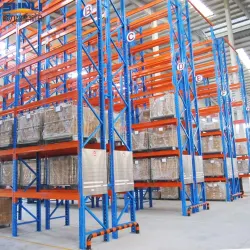Key features and considerations related to cantilever racks
2023-11-27
Cantilever racks are a type of storage system designed to facilitate the organized and efficient storage of long, bulky items that don't fit well on traditional pallet racks. These racks are characterized by arms that extend from vertical columns, creating a structure that allows for easy loading and unloading of items. Cantilever racks are commonly used for storing items such as lumber, pipes, tubing, and other lengthy goods. Here are key features and considerations related to cantilever racks:
Components of Cantilever Racks:
1. Vertical Columns (Uprights):
- Vertical columns provide the structural support for the cantilever rack system. They typically consist of two upright posts connected by horizontal and diagonal braces.
2. Cantilever Arms:
- Horizontal arms extend outward from the upright columns. These arms support the stored items and allow for easy loading and unloading with forklifts or other handling equipment.
3. Bracing and Base:
- Horizontal and diagonal bracing connects the upright columns, providing stability to the rack structure. The base supports the entire system and is often anchored to the floor for added stability.
4. Bolted Connections:
- Cantilever racks are often assembled using bolted connections, allowing for flexibility in configuration and adjustments.
Types of Cantilever Racks:
1. Single-Sided Cantilever Racks:
- Single-sided racks have arms on one side only. They are typically placed against a wall or in a row where access is only required from one side.
2. Double-Sided Cantilever Racks:
- Double-sided racks have arms on both sides, allowing for access from either side. These racks are placed in the center of an aisle, providing more accessibility.
3. Roll-Out Cantilever Racks:
- Features arms that can be rolled out for easy loading and unloading. This design enhances efficiency by eliminating the need to reach deep into the rack.
4. Heavy-Duty Cantilever Racks:
- Built to support particularly heavy loads, these racks are designed with robust components and may have additional bracing for increased stability.
5. Light-Duty Cantilever Racks:
- Suitable for lighter loads and smaller items. Light-duty cantilever racks are often used in retail environments or for storing lightweight materials.
Considerations for Cantilever Racks:
1. Length of Items:
- Cantilever racks are ideal for storing long and unwieldy items. Consider the length and weight of the items to be stored when selecting the appropriate rack.
2. Vertical Space:
- Cantilever racks allow for the vertical storage of items, maximizing space in warehouses or storage facilities. Consider the available vertical space when planning the rack configuration.
3. Accessibility:
- Cantilever racks provide easy access to items, as there are no vertical obstructions. This makes them suitable for applications where frequent loading and unloading are required.
4. Load Capacity:
- Determine the load capacity of the cantilever racks based on the weight and dimensions of the items to be stored. Heavy-duty racks may be needed for particularly large or heavy items.
5. Warehouse Layout:
- Plan the layout of cantilever racks to optimize aisle width and the overall flow of goods within the storage facility.
6. Safety Measures:
- Ensure that safety measures, such as proper anchoring, are implemented to prevent accidents or structural issues.
Cantilever racks are a versatile and efficient solution for the storage of long and heavy items, providing easy accessibility and maximizing space utilization. When choosing cantilever racks, it's important to consider the specific storage needs, load requirements, and the overall layout of the storage facility.



